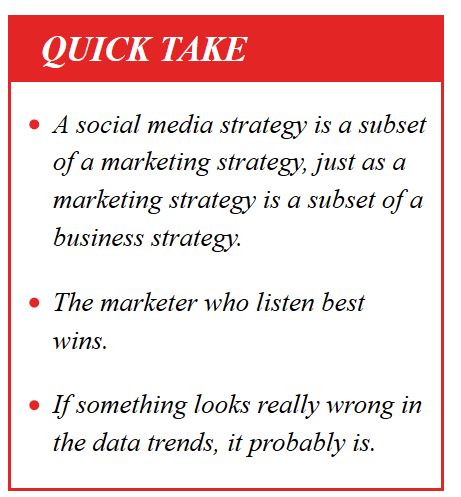(photo credit: Carl Muza)
Social media has evolved from a broadcast marketing opportunity to something that can be leveraged by CMOs to serve customers, inform product and service innovations, reduce costs, and boost shareholder value. There are deep analytics to gather and understand, dynamic web sites to create (and recreate), and customer experiences to define – all while remembering to do social good, and be inclusive and diverse. It’s technical, creative, data-driven, and customer-centric. It’s impossible to be an expert at one’s own job because there are far too many micro-specialties to govern over. And it’s absolutely exhausting.
What is a marketing leader to do?
-
Plan strategically
Repeat after me: a social media campaign, no matter how big or expensive, is not a strategy. Some CMOs lose sight of this because social media is new and complex and has different demands and requirements. Stick with what you know to be true!
A social media strategy is a subset of a marketing strategy, just as a marketing strategy is a subset of a business strategy. Every social media campaign MUST cascade to an impact on the bottom line or a business goal. That’s what makes CEOs and board members sit up at listen.
To ensure that all pieces of the strategy puzzle fit together, some marketing executives find it helpful to use a Social Business Strategy Map – which enables them to define their strategies and align them with operations. After all, strategy without strong execution is meaningless. I developed this strategy map in partnership with Palladium Group – founders of the Balanced Scorecard approach – and it is now being used around the world.
-
Communicate clearly
Once you’ve nailed your strategy, make sure you communicate it to the organization – early and often. In an era where employees can be a brand’s biggest advocates – and they have the social tools to engage directly with customers – keeping everyone (not just the marketing team) on the same page can create a powerful unified front.
And keep this in mind: Every year, the marketing communications firm Edelman publishes its Trust Barometer – which measures our trust in institutions, including business, media, NGOs, and government. Findings from this year’s survey indicate that employees want to see their business leaders as human. In fact, almost eight in ten say that hearing information about personal values is important to building trust in a leader. Just as important is learning about the obstacles a leader has overcome as well as their personal success story.
So when you’re communicating your strategy to the organization, take off your corporate hat and put on your human hat. Focus less on the dry mechanics of the strategy and more on articulating the challenges and opportunities as you see them – and on how employees can play a role in the company’s success. That’s the key to employee advocacy.
-
Experiment and take calculated risks
Before big data and analytics, CMOs had to guess at market perception and trends. They based their messages on feedback from product or service teams (or from surveys and focus groups) vs. getting them directly from the customer. And they had no hard and fast way of knowing if their campaigns and strategies were fruitful.
Today, marketing leaders are combining data, market messages, and omni-channel approaches. Award-winning CMOs are reaching new levels of success by taking calculated risks and capturing the results in order to learn from them.
A great example of the power of this process is Big Lots, the discount retailer. Prior to appointing CMO Andrew Stein, the company had made a series of wrong assumptions about its customer base – including assuming that most buyers were cash-strapped and looking for low prices. With Stein at the helm, the company used customer research and analytics to conclude that Big Lots customers come from all walks of life and income brackets, but share a common goal: to score a great deal.
of wrong assumptions about its customer base – including assuming that most buyers were cash-strapped and looking for low prices. With Stein at the helm, the company used customer research and analytics to conclude that Big Lots customers come from all walks of life and income brackets, but share a common goal: to score a great deal.
Armed with that insight, Big Lots launched a video on Black Friday, which did extremely well. So they kept it up. The next video, “Nailing this Christmas” went viral and endeared the store chain to its current and prospective customers by making discount shopping an exciting badge of honor. The ads feature a diverse group of women, so they appeal to an inclusive marketing agenda as well.
-
Staff wisely
In the digital age, winning marketing teams need to focus on both inbound and outbound marketing. This requires a diverse group of talented specialists who may not have the backgrounds of traditional marketers – from data scientists and pipeline specialists to community managers and journalists.
Your marketing team may even start to look more like an IT team – and that’s a good thing. In fact, Gartner predicts that by 2017, marketing functions will spend more on technology investments than the IT function does.
This shift may also mean that traditional org charts are no longer relevant. Case in point: according to Brian Doll, VP of Marketing at Github, the company’s marketing org chart is largely flat and contains few titles – just team names to encourage a culture of collaboration. Or consider Procter and Gamble. Last year, the company restructured its marketing function to become “Brand Management” with single-point responsibility for the strategies, plans, and results for the brands. P&G’s Brand Management organization now sits within the global business function.
So take stock of your staff portfolio and explore any gaps you may have. Do you have technical wizards who can find, integrate, and own the best marketing platforms (within the corporate IT standards). Do you have quants (aka quantitative analysts) to oversee data collection and make sense of the numbers? Do you have an ethnographer or social scientist to understand your customer personas and experiences? How about technically savvy design pros to create compelling visual content? You’re going to need ‘em all.
-
Listen well
There’s a new kind of listening – and it’s not based on what your executives, or your agencies, are saying. It’s all about what your customers – both internal and external – are telling you.
What are your customers thinking, feeling, doing, wanting? What does sales need to feel supported? What are the business lines’ future innovation plans? The modern customer expects a modern marketer to understand them and provide them with what they need, when they need it … and even sometimes, before they ask.
The good news is that listening is easier than ever. We live in an age of live, continual focus groups and feedback forums – and marketing leaders can use these to keep an ear to the ground, trend spot, and tap into customer sentiments like never before!
Take Hitachi Data Systems. Their developer and partner network is so important to the company’s innovation that they are now partnering with them directly, asking them what they need, and delivering it. Instead of gathering developers and partners together twice a year at a partner summit, Hitachi is cutting to the chase – by using social channels to get customer input and refine innovations based on their feedback. Remember: The marketer who listen best wins.
-
Track carefully
Data, data everywhere but not a drop to drink. Most CMOs agree that they are drowning in data. The solution? Don’t measure everything – track in smaller segments. For example, focus in on a specific sub-demographic or customer type that your brand wants to reach or engage with. Or do something as simple as following hashtags or tracking sentiment – a smaller endeavor that can deliver big insights.
Think like a researcher – starting with a hunch or hypothesis that you can test with data. Then, rely on your gut instincts. If something looks really wrong in the data trends, it probably is. Test and re-test to be sure that your analysis is strong.
Above all else, be sure to use analytics to serve meaningful business needs. CMOs can lose their strategic way if they don’t know what they want to learn from the analytics. Don’t get lost in the numbers to the point that you can’t see the big picture.
A version of this post originally appeared on CMO.com: http://scl.io/xb-0O2yz#gs.IMwQHnE
Warning: Attempt to read property "base" on array in /home3/trusten9/public_html/leadernetworks/wp-content/plugins/wp-user-profile-avatar/shortcodes/wp-user-profile-avatar-shortcodes.php on line 665
Warning: Attempt to read property "base" on array in /home3/trusten9/public_html/leadernetworks/wp-content/plugins/wp-user-profile-avatar/shortcodes/wp-user-profile-avatar-shortcodes.php on line 665
Warning: Attempt to read property "base" on array in /home3/trusten9/public_html/leadernetworks/wp-content/plugins/wp-user-profile-avatar/shortcodes/wp-user-profile-avatar-shortcodes.php on line 665
Warning: Attempt to read property "base" on array in /home3/trusten9/public_html/leadernetworks/wp-content/plugins/wp-user-profile-avatar/shortcodes/wp-user-profile-avatar-shortcodes.php on line 665
Vanessa DiMauro
Internationally recognized independent thought leader on social business strategy and operations with a specialty in online community. I help organizations drive top line growth through innovative digital strategy design and thoughtful execution. I have successfully led 60+ strategic social business initiatives for the world's most influential organizations over my 20 years as a social business executive and serve on a number of boards. My award-winning track-record is fueled by passion, experience and research.
My work has been covered by leading publications such as the New York Times, the Wall Street Journal and CIO Magazine and was recently named a Social Marketing Master by Forbes. As a former Executive in Residence at Babson College, Olin School of Management, I am an engaging and informational educator and keynote speaker.
Related Posts
July 18, 2016
#RepresentationMatters, Your Guide to Inclusive Marketing
Inclusive Marketing strives to create a visual culture that is more…
December 19, 2015
Robin Carey Danced on the Stage of Life
Beautiful. Visionary. Witty. Feminist. Passionate. Loved. Robin Fray Carey…
December 15, 2015
Why Inclusive Marketing should be on Your Agenda for 2016
Your guide to doing inclusive marketing - the right way!
1 Comment
Add comment Cancel reply
This site uses Akismet to reduce spam. Learn how your comment data is processed.




I think tracking what works and what’s not is definitely something that should be focused on. It’s a big waste to continue strategies if they aren’t converting.